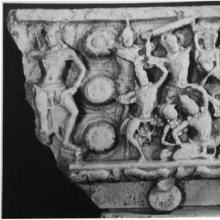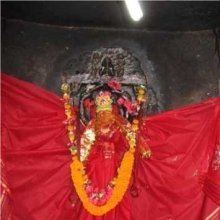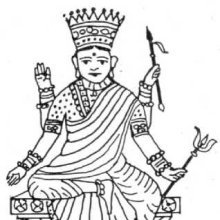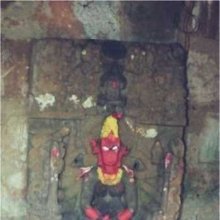Rohini, Rohiṇi, Rohiṇī, Rohinī: 45 definitions
Introduction:
Rohini means something in Buddhism, Pali, Hinduism, Sanskrit, Jainism, Prakrit, the history of ancient India, Marathi, biology. If you want to know the exact meaning, history, etymology or English translation of this term then check out the descriptions on this page. Add your comment or reference to a book if you want to contribute to this summary article.
Images (photo gallery)
In Hinduism
Shilpashastra (iconography)
Source: Wisdom Library: Elements of Hindu IconograpyRohiṇī (रोहिणी):—The consort of Mahādeva (aspect of Śiva, as in, one of the eight names of Rudra) according to the Pādma-purāṇa. (according to the Viṣṇu-purāṇa she is called Vikesī)
Source: archive.org: Illustrations of Indian Music and Dance in Western Indian StyleRohiṇī (रोहिणी, “ascending”).—Illustration of Rohiṇī-śruti according to 15th century art:—The colour of her body is golden. She holds a vīṇā with her right hand and a flower in her left hand. The colour of her bodice is green and the scarf is sky-blue with a crimson-coloured design with red coloured borders. The lower garment is yellow with a black-coloured design and borders of red colour. Another garment of red colour with a white design is on the waist.
The illustrations (of, for example Rohiṇī) are found scattered throughout ancient Jain manuscripts from Gujarat. The descriptions of these illustrations of this citrāvalī are based on the ślokas of Vācanācārya Gaṇi Sudhākalaśa’s Saṅgītopaniṣatsāroddhāra (14th century) and Śārṅgadeva’s Saṅgītaratnākara (13th century).
Source: Shodhganga: The significance of the mūla-beras (śilpa)Rohinī is the name of deity as found depicted in the Meenakshi Temple in Madurai (or Madura), which represents a sacred place for the worship of The Goddess (Devī).—Rohinī is found with the left hand in dolā and the right hand in kaṭaka.
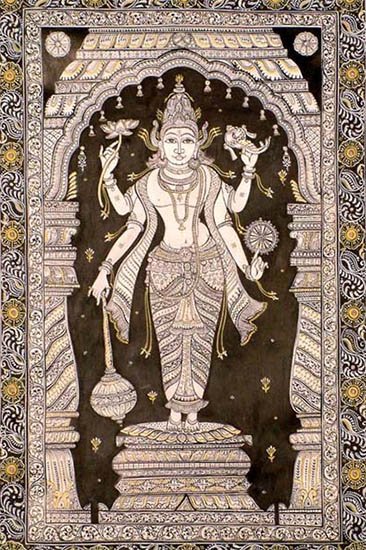
Shilpashastra (शिल्पशास्त्र, śilpaśāstra) represents the ancient Indian science (shastra) of creative arts (shilpa) such as sculpture, iconography and painting. Closely related to Vastushastra (architecture), they often share the same literature.
Ayurveda (science of life)
Rasashastra (Alchemy and Herbo-Mineral preparations)
Source: Wisdom Library: Rasa-śāstraRohiṇī (रोहिणी):—One of the sixty-four Divyauṣadhi, which are powerful drugs for solidifying mercury (rasa), according to Rasaprakāśa-sudhākara (chapter 9).
Cikitsa (natural therapy and treatment for medical conditions)
Source: Wisdom Library: Ayurveda: Cikitsa1) Rohiṇi (रोहिणि):—One of the seven varieties of Harītakī (‘yellow myrobalan tree’), which is used throughout Ayurvedic literature such as the Caraka-saṃhitā. The fruit is circular in shape and useful for healing wounds. It is found in the place called Pratishtanaka.
2) Rohiṇī (रोहिणी):—Another name for Kaṭuka (Picrorhiza kurroa), a species of medicinal plant and used in the treatment of fever (jvara), as described in the Jvaracikitsā (or “the treatment of fever”) which is part of the 7th-century Mādhavacikitsā, a Sanskrit classical work on Āyurveda. This synonym is also identified by Bhāvamiśra in his 16th century Bhāvaprakāśa. Certain plant parts are eaten as vegetables.
3) Rohiṇī (रोहिणी) is a Sanskrit word referring to the “tropic bird”. The meat of this animal is part of the māṃsavarga (‘group of flesh’), which is used throughout Ayurvedic literature. The animal Rohiṇī is part of the sub-group named Ambucārin, refering to animals “which move on waters”. It was classified by Caraka in his Carakasaṃhitā sūtrasthāna (chapter 27), a classical Ayurvedic work. Caraka defined such groups (vargas) based on the dietic properties of the substance.
Source: Ancient Science of Life: Botanical identification of plants described in Mādhava CikitsāRohiṇī (रोहिणी) or Kaṭurohiṇī refers to the medicinal plant Picrorrhiza kurroa Benth., and is used in the treatment of atisāra (diarrhoea), according to the 7th century Mādhavacikitsā chapter 2. Atisāra refers to a condition where there are three or more loose or liquid stools (bowel movements) per day or more stool than normal. The second chapter of the Mādhavacikitsā explains several preparations [including Rohiṇī] through 60 Sanskrit verses about treating this problem.
The plant Picrorrhiza kurroa Benth. (Rohiṇī) is also known as Kaṭuka according to both the Ayurvedic Formulary and the Ayurvedic Pharmacopoeia of India.
Toxicology (Study and Treatment of poison)
Source: Shodhganga: Kasyapa Samhita—Text on Visha ChikitsaRohiṇī (रोहिणी) (Nakṣatra) is considered negative for the recovery for a person to be bitten by snake, as taught in the Kāśyapa Saṃhitā: an ancient Sanskrit text from the Pāñcarātra tradition dealing with both Tantra and Viṣacikitsā—an important topic from Āyurveda which deals with the study of Toxicology (Agadatantra or Sarpavidyā).—The malignant asterisms and baneful lunar phases and astral combinations, with reference to snake-bite, are discussed in the tail-end of the fourth Adhyāya. [...] The Kāśyapasaṃhitā mentions the following details regarding the Nakṣatras:—The stars of a malignant nature that determine the virulence of the poison of the snake bite are [e.g., Rohiṇī] (Cf. verse IV.108)

Āyurveda (आयुर्वेद, ayurveda) is a branch of Indian science dealing with medicine, herbalism, taxology, anatomy, surgery, alchemy and related topics. Traditional practice of Āyurveda in ancient India dates back to at least the first millenium BC. Literature is commonly written in Sanskrit using various poetic metres.
Jyotisha (astronomy and astrology)
Source: Wisdom Library: JyotiṣaRohiṇī (रोहिणी):—Name for a particular section of the ecliptic. It is also known as Rohiṇīnakṣatra Nakṣatra means “Lunar mansion” and corresponds to a specific region of the sky through which the moon passes each day. Rohiṇī means “the red one” and is associated with the deity known as Prajāpati (the Creator, Brahmā). The presiding Lord of this lunar house is Chandra (Moon). Also known as the Brāhmīnakṣatra.
Indian zodiac: |10°| – |23°20' Vṛṣabha|
Vṛṣabha (वृषभ, ‘bull’) corresponds Taurus
Western zodiac: |6°| – |19°20' Gemini|
Gemini corresponds with Mithuna (मिथुन, ‘twins’).
Rohiṇī (रोहिणी) refers to one of the twenty-eight Nakṣatras (constellations), according to the Bṛhatsaṃhitā (chapter 15) (“On the nakṣatras—‘asterisms’”), an encyclopedic Sanskrit work written by Varāhamihira mainly focusing on the science of ancient Indian astronomy astronomy (Jyotiṣa).—Accordingly, “Those who are born on the lunar day of Kṛttikā will delight in white flowers, will perform sacrificial rites, will be Brāhmins, potters, priests or astronomers. Those who are born on the lunar day of Rohiṇī will be devout men, merchants, rulers, rich men, Yogis, drivers, or men possessed of cows, cattle and the animals of water, farmers and men possessed of wealth derived from mountain produce”.

Jyotisha (ज्योतिष, jyotiṣa or jyotish) refers to ‘astronomy’ or “Vedic astrology” and represents the fifth of the six Vedangas (additional sciences to be studied along with the Vedas). Jyotisha concerns itself with the study and prediction of the movements of celestial bodies, in order to calculate the auspicious time for rituals and ceremonies.
Vaishnavism (Vaishava dharma)
Source: ISKCON Press: GlossaryRohiṇī (रोहिणी).—The wife of Vasudeva, and the mother of Lord Balarāma.

Vaishnava (वैष्णव, vaiṣṇava) or vaishnavism (vaiṣṇavism) represents a tradition of Hinduism worshipping Vishnu as the supreme Lord. Similar to the Shaktism and Shaivism traditions, Vaishnavism also developed as an individual movement, famous for its exposition of the dashavatara (‘ten avatars of Vishnu’).
Natyashastra (theatrics and dramaturgy)
Source: Wisdom Library: Nāṭya-śāstraRohiṇī (रोहिणी) is a Sanskrit word referring to the asterism Aldeberan. According to the Nāṭyaśāstra 2.43-46, the ceremony of “raising the pillars” within the playhouse (nāṭyamaṇḍapa) should be performed during an auspicious tithi and karaṇa under either the asterism Rohiṇī or Śravaṇā. Accordingly, “the master [of dramatic art], after he has fasted for three [days and] nights, is to raise the pillars in an auspicious moment at dawn”. These two asterisms are considered auspicious for this purpose.
Source: Wisdom Library: SaṅgītaśiromaṇiRohiṇī (रोहिणी) refers to one of the twenty-two quarters tones (śruti) existing within an octave, according to the Saṅgīta-ratnākara (“ocean of music and dance”). This work is an important Sanskrit treatise dealing with ancient Indian musicology (gāndharva-śāstra), composed by Śārṅgadeva in the 13th century and deals with both Carnatic and Hindustani music. Rohiṇī has a frequency of 418.6009Hz.

Natyashastra (नाट्यशास्त्र, nāṭyaśāstra) refers to both the ancient Indian tradition (shastra) of performing arts, (natya—theatrics, drama, dance, music), as well as the name of a Sanskrit work dealing with these subjects. It also teaches the rules for composing Dramatic plays (nataka), construction and performance of Theater, and Poetic works (kavya).
Purana and Itihasa (epic history)
Source: archive.org: Puranic Encyclopedia1) Rohiṇī (रोहिणी).—The mother of all the cows. The following is a story about the origin of Rohiṇī, given in Vālmīki Rāmāyaṇa, Araṇya Kāṇḍa, Sarga 14.
Prajāpati Kaśyapa married Surabhi the seventh daughter of Dakṣa. Two daughters Rohiṇī and Gandharvī, were born to Surabhi. In later years cows and oxen were born in the world from Rohiṇī and horses from Gandharvī. In the Mahābhārata, Sabhā Parva, Chapter 66, it is mentioned that two daughters Vimalā and Analā were born to Rohiṇī and that from these two, in later years cattle were born. (See full article at Story of Rohiṇī from the Puranic encyclopaedia by Vettam Mani)
2) Rohiṇī (रोहिणी).—General information. One of the wives of Candra (Moon). The twentyseven stars are the wives of Candra. Of these twentyseven wives, Rohiṇī was loved most by Candra. (See under Candra). Rohiṇī and Daśaratha. (See under Daśaratha, Para 10).
3) Rohiṇī (रोहिणी).—The mother of Balabhadrarāma. General information. Vasudeva had two wives Devakī and Rohiṇī. Śrī Kṛṣṇa was born from Devakī and Balabhadrarāma from Rohiṇī. Previous Birth of Rohiṇī. Vasudeva was the rebirth of Prajāpati Kaśyapa. When Kaśyapa took birth as Vasudeva, his two wives Aditi and Surasā took birth as Devakī and Rohiṇī respectively. (They took birth thus, because of the curse of Varuṇa. For details of the curse see under Kaśyapa, para 6). The birth of Balabhadra. The seventh child of Devakī was placed in the womb of Rohiṇī and Balabhadrarāma was born. (For this story see under Kṛṣṇa, para 6, Kaṃsa, para 6 and Ṣaḍarbhaka). Death. As soon as a messenger named Dāruka brought the news that the entire race of the Yādavas had perished in Dvārakā, “because of grief, Vasudeva, Devakī and Rohiṇī forsook their bodies”. (Bhāgavata, Skandha 11).
4) Rohiṇī (रोहिणी).—Niśā the third wife of the Agni (fire) called Manu or Bhānu gave birth to a daughter named Rohiṇī. Because she had done some misdeeds, she became the wife of Hiraṇyakaśipu. (Mahābhārata Vana Parva, Chapter 221).
5) Rohiṇī (रोहिणी).—The mother of Utatthya, a famous hermit. (For details see under Satyatapas).
Source: archive.org: Nilamata Purana: a cultural and literary studyRohiṇī (रोहिणी) is the name of a Nakṣatra mentioned in the Nīlamatapurāṇa verse 710. As regards the heavenly bodies, the Nīlamata refers to the sun, the moon, the planets and the stars. The divisions of the time are also mentioned as objects of worship.
Source: archive.org: Shiva Purana - English Translation1) Rohiṇī (रोहिणी) is refers to one of the several daughters of Dakṣa, as mentioned in the Śivapurāṇa 2.2.6. Accordingly, as Śiva said to Sandhyā:—“[...] O Sandhyā, while you were performing severe penance—which had lasted for four yugas—in the earlier part of Tretā-yuga, after the Kṛta-yuga had elapsed, Dakṣa had begotten many chaste daughters who were also duly married. He gave twenty seven of his daughters to the moon in marriage. But the moon had a special liking for only Rohiṇī and he neglected others. Hence, the moon was cursed by Dakṣa, the redemption being, when he sees the Ether he would find her there”.
Note: Rohiṇī, according to Paurāṇic Mythology, was the daughter of Dakṣa and the favourite wife of the moon.
2) Rohiṇī (रोहिणी) refers to one of the sixteen celestial ladies (Divyanārī), according to the Śivapurāṇa 2.3.50 (“Description of fun and frolic”).—Accordingly, as Brahmā narrated to Nārada: “[...] Then the sixteen celestial ladies arrived there and saw the couple [i.e., Śiva and Pārvatī] with great respect. They were Sarasvatī, Lakṣmī, Sāvitrī, Jāhnavī, Aditi, Śacī, Lopāmudrā, Arundhatī, Ahalyā, Tulasī, Svāhā, Rohiṇī, Vasundharā, Śatarūpā, Saṃjñā and Rati. There were several virgins of the gods, Nāgas, and the sages. They were charming and attractive. Who can enumerate them? [...]”.
Source: Cologne Digital Sanskrit Dictionaries: The Purana Index1a) Rohiṇī (रोहिणी).—A daughter of Vālmīki; one of Vasudeva's wives, and mother of Gada, Balarāma and five other sons besides a daughter, Citrā.1 Had her residence at Nandagokula. Hari ordered Yogamāyā to transfer his dhāma in the womb of Devakī to that of Rohiṇī. This was the future Balarāma Saṅkarṣana. Nārada spoke about this to Kaṃsa.2 Her joy at the birth of Kṛṣṇa, and helped Yaśodā in her rakṣa ritual to Kṛṣṇa; joy at his escape from Kālīya; intensely attached to Rāma; surprised at Kṛṣṇa holding the Govardhana; came to see him taking Pārijāta from Indra's abode. Kṛṣṇa's respects to;3 went to Syamantapañcaka for the solar eclipse, met Yaśodā there and embraced her. Lamented the decease of Kṛṣṇa and Rāma.4 Entered fire after their deceuse;5 also known as Pauravī.6
- 1) Bhāgavata-purāṇa IX. 24. 45-6; X. 1. 8; Brahmāṇḍa-purāṇa III. 71. 161-5; Vāyu-purāṇa 96. 160-3; Viṣṇu-purāṇa V. 1. 74-6; 2. 2; 5. 5; 6. 11; IV. 15. 18-9.
- 2) Bhāgavata-purāṇa X. 2. 7-8, 15.
- 3) Ib. X 5. 17; 6. 19; 11. 12; 15. 44; 17. 15; 25. 30; 36. 17; [67 (v) 47-8].
- 4) Ib. X. 82. 37; XI. 31. 18.
- 5) Viṣṇu-purāṇa V. 38. 4.
- 6) Matsya-purāṇa 46. 11.
1b) One of Kṛṣṇa's wives; a Devī; mother of Dīptimat, Tāmrapakṣa and other sons.*
- * Bhāgavata-purāṇa X, 61. 18; Brahmāṇḍa-purāṇa III. 71. 242; Vāyu-purāṇa 96. 233. Viṣṇu-purāṇa V. 28. 4; 32. 2.
1c) A wife of Mahādeva-Candramatanu of Śiva; mother of Budha.*
- * Brahmāṇḍa-purāṇa I. 2. 9; II. 10. 84; Matsya-purāṇa 55. 12; 139. 25; Vāyu-purāṇa 27. 56; 66. 22. Viṣṇu-purāṇa I. 8. 8.
1d) A daughter of Surabhī and Kaśyapa; a sister of the Rudras; mother of four daughters—Surūpā, Haṃsakālī (kīlā), Bhadrā and Kāmadu(a)ghā.*
- * Brahmāṇḍa-purāṇa III. 3. 73-5; Vāyu-purāṇa 66. 71-72.
1e) A constellation important for śrāddha performance;1 the worship of, in go sahasra dāna.2
- 1) Brahmāṇḍa-purāṇa III. 18. 3; Matsya-purāṇa 17. 3; 54. 9; Vāyu-purāṇa 82. 3.
- 2) Matsya-purāṇa 163. 41; 171. 32; 278. 14.
1f) Had Saumya as her son.*
- * Vāyu-purāṇa 2. 9.
Rohiṇī (रोहिणी) is a name mentioned in the Mahābhārata (cf. I.60.64) and represents one of the many proper names used for people and places. Note: The Mahābhārata (mentioning Rohiṇī) is a Sanskrit epic poem consisting of 100,000 ślokas (metrical verses) and is over 2000 years old.
Source: Shodhganga: The saurapurana - a critical studyRohiṇī (रोहिणी) refers to one of the two wives of Vasudeva: one of the sons of Kroṣṭā, according to the Vaṃśānucarita section of the 10th century Saurapurāṇa: one of the various Upapurāṇas depicting Śaivism.—Accordingly, [...] The Son of Yadu was Kroṣṭā in whose race the most glorious kings were born. The text only names them as [viz., Vasudeva]. Ugrasena’s daughter was Devakī who married Vasudeva and from them Viṣṇu by the curse of Bhṛgu was born as Kṛṣṇa. From Vasudeva’s other wife Rohiṇī was born Saṃkarṣaṇa.

The Purana (पुराण, purāṇas) refers to Sanskrit literature preserving ancient India’s vast cultural history, including historical legends, religious ceremonies, various arts and sciences. The eighteen mahapuranas total over 400,000 shlokas (metrical couplets) and date to at least several centuries BCE.
Shaktism (Shakta philosophy)
Source: Google Books: ManthanabhairavatantramRohiṇī (रोहिणी) refers to one of the eight Kaula consorts (dūtī-aṣṭaka) associated with Tisrapīṭha (located in the ‘end of sound’—nādānta), according to the Manthānabhairavatantra, a vast sprawling work that belongs to a corpus of Tantric texts concerned with the worship of the goddess Kubjikā.—[...] The eight Kaula consorts (dūtyaṣṭaka): Revatī, Bhagavatī, Rāmā, Rohiṇī, Kṛttikā, Khecarī, Khaṇḍinī, Kṣānti
Source: Brill: Śaivism and the Tantric Traditions (shaktism)Rohiṇī (रोहिणी) refers to one of the nine Goddess to be worshiped as part of the Navarātra Tantric ritual (an autumnal festival of the warrior goddess Caṇḍikā).—From Pratipat to Navamī: daily worship by the king of nine maidens (kumārīpūjā) as nine goddesses, Kumārī, Trimūrti/Trimurtinī, Kalyāṇī, Rohiṇī, Kālikā, Caṇḍikā, Śāmbhavī, Durgā, Bhadrā.—Various 14th century sources refer to rituals involving the worship of Rohiṇī, for example: Caturvargacintāmaṇi, Sāmrājyalakṣmīpīṭhikā, Puruṣārthacintāmaṇi, accounts of ceremonies in Śivagaṅgai and Ramnad, Tamil Nadu (Price 1996), Portuguese traveler accounts from the Vijayanagara Empire (Stein 1983).

Shakta (शाक्त, śākta) or Shaktism (śāktism) represents a tradition of Hinduism where the Goddess (Devi) is revered and worshipped. Shakta literature includes a range of scriptures, including various Agamas and Tantras, although its roots may be traced back to the Vedas.
General definition (in Hinduism)
Source: archive.org: Vedic index of Names and SubjectsRohiṇī (रोहिणी, ‘ruddy’) is the name of the conspicuously reddish star, α Tauri or Aldebaran, and denotes the group of the Hyades, α θ γ δ ε Tauri. Its identification seems absolutely assured by the legend of Prajāpati in the Aitareya-brāhmaṇa. He is there represented as pursuing his daughter with incestuous intention, and as having been shot with an arrow (Iṣu Trikāṇḍā, ‘the belt of Orion’) by the ‘huntsman’ (Mṛgavyādha, ‘Sirius’). Prajāpati is clearly Orion (Mṛgaśiras being the name of the little group of stars in Orion’s head).
Source: Apam Napat: Indian MythologyRohini is a daughter of Daksha. She was married to Chandra, the moon, alongwith twenty-six of her sisters. The twenty-seven sisters are the twenty-seven constellations in Indian Astrology. Her father had secured the promise that all of them would be treated equally from Chandra. However, Chandra favored Rohini above all and broke his promise to his father-in-law. For this broken promise, he was cursed by Daksha.
Source: WikiPedia: HinduismRohiṇi (रोहिणि): The wife of Vasudeva and mother of Balarama
In Buddhism
Theravada (major branch of Buddhism)
Source: Pali Kanon: Pali Proper Names1. Rohini Theri. She was the daughter of a prosperous brahmin of Vesali. When the Buddha visited Vesali, she heard him preach and became a sotapanna, taught the Doctrine to her parents, and, with their permission, entered the Order, where she became an arahant.
Ninety one kappas ago she saw Vipassi Buddha begging in Bandhumati, and, filling his bowl with meal cakes, paid him homage (ThagA.214f).
The Therigitha (vss.271-90) contains a set of verses spoken by her in exaltation, when, after becoming an arahant, she recalled to mind the discussion she had had with her father while she was yet a sotapanna.
It is said (ThigA.219f) that the last stanza of the series was spoken by her father, who later himself joined the Order and became an arahant.
2. Rohini. Sister of Anuruddha Thera. When he visited his family at Kapilavatthu, she refused to see him because she was suffering from a skin eruption. But Anuruddha sent for her, and when she came, her face covered with a cloth, he advised her to erect an assembly hall for the monks. She consented to do this, sold her jewels, and erected a hall of two stories, the building of which was supervised by Anuruddha. At the dedication ceremony she entertained the Buddha and the monks. At the conclusion of the meal the Buddha sent for her. She was reluctant to go to him owing to her disease, but was persuaded, and he told her the story of her past.
Long ago she had been the chief consort of the king of Benares, and being jealous of a dancing girl whom the king loved, she contrived to get powdered scabs on the girls body, clothes and bed. The girl developed boils and her skin was ruined.
At the conclusion of the Buddhas sermon, Rohinis disease vanished and her body took on a golden color, while she herself was established in the First Fruit of the Path. After death, Rohini was born in Tavatimsa, at the meeting point of the boundaries of four deities. Because of her beauty, each deity claimed her as his, and they referred their quarrel to Sakka. Sakka, too, became enamored of her, and when he confessed his desire, they agreed to let hint take her, and she became his special favourite. DhA.iii.295ff.
3. Rohini. A small river dividing the Sakyan and Koliyan countries. A dam was constructed across the river, and the people on the two sides used the water to cultivate their fields. Once, in the month of Jetthamula, there was a drought, and a violent quarrel arose between the two peoples for the use of the water. A battle was imminent, when the Buddha, seeing what was about to happen, appeared in the air between the opposing forces in the middle of the river and convinced them of the folly of killing each other for the sake of a little water. It is said that he preached on this occasion the Attadanda Sutta and the Phandana, the Latukika and the Vattaka Jatakas.
Theravāda is a major branch of Buddhism having the the Pali canon (tipitaka) as their canonical literature, which includes the vinaya-pitaka (monastic rules), the sutta-pitaka (Buddhist sermons) and the abhidhamma-pitaka (philosophy and psychology).
Mahayana (major branch of Buddhism)
Source: Wisdom Library: Maha Prajnaparamita SastraRohiṇī (रोहिणी) refers to one of the twenty-seven constellations (nakṣatra) according to according to Mahāprajñāpāramitāśāstra (chapter XIV).—Rohiṇī is the Sanskrit equivalent of Chinese Pi, Tibetan Sanr-ma and modern Tauri.
Rohiṇī is classified in the fourth group: “The moon revolves around the earth in 28 days. If the moon enters one of the nine following constellations (e.g., Rohiṇī), then at that moment the earth trembles as if it would collapse and this trembling extends as far as Devendra. Then peace (yogakṣema) is plentiful, rain favors the growth of the five grains, the emperor is kind (śiva), the great ministers are virtuous and everyone is peaceful”.
Source: archive.org: Bulletin of the French School of the Far East (volume 5)Rohiṇī (रोहिणी) is the name of a Nakṣatra mentioned in chapter 18 of the Candragarbha: the 55th section of the Mahāsaṃnipāta-sūtra, a large compilation of Sūtras (texts) in Mahāyāna Buddhism partly available in Sanskrit, Tibetan and Chinese.—Chapter 18 deals with geographical astrology and, in conversation with Brahmarāja and others, Buddha explains how he entrusts the Nakṣatras [e.g., Rohiṇī] with a group of kingdoms for the sake of protection and prosperity.
The Rohiṇīnakṣatra comprises the following realms:
- Mo-kia-t'o (Magadha),
- Pi-t'i-ho (Videha),
- Sa-lo (Sara?),
- Hi-feou-kia (Hebuka?),
- Meou-ni-chö-ye (Muniśaya?),
- Lo-lo (Lala or Lāṭa?),
- Yu-ni-kia (Yonika?),
- Keou-sa-lo (Kosala),
- Po-cha-kia (Vaṣaga?),
- A-tch'a (Aṭa),
- Pi-ho-kia (Vehaka?),
- Ngo-na-p'o (Aṃnava?),
- Kia-ye (Gayā),
- Ni-p'o (Nipa?),
- P'an-lo-p'o (Baṃrava?),
- Po-tche-ni (Paṭini?),
- T'o-leou (Dāru?),
- Che-li-man-to (Śrīmanta?),
- Mi-kia-p'o-lo (Migaphala?),
- Mo-hi-cheou-lo-ni-lo-ye (Maheśvaranilaya),
- Ki-pin (Kapiśa),
- Pó-lou-che-to (Varuśita?),
- Cha-le (Kachgar),
- Yin-ni (?),
- Chai-t'i (Ṣadhi?).

Mahayana (महायान, mahāyāna) is a major branch of Buddhism focusing on the path of a Bodhisattva (spiritual aspirants/ enlightened beings). Extant literature is vast and primarely composed in the Sanskrit language. There are many sūtras of which some of the earliest are the various Prajñāpāramitā sūtras.
Tibetan Buddhism (Vajrayana or tantric Buddhism)
Source: Wisdom Library: Tibetan Buddhism1) Rohiṇī (रोहिणी) refers to one of the female Śrāvakas mentioned as attending the teachings in the 6th century Mañjuśrīmūlakalpa: one of the largest Kriyā Tantras devoted to Mañjuśrī (the Bodhisattva of wisdom) representing an encyclopedia of knowledge primarily concerned with ritualistic elements in Buddhism. The teachings in this text originate from Mañjuśrī and were taught to and by Buddha Śākyamuni in the presence of a large audience (including Rohiṇī).
2) Rohiṇī (रोहिणी) also refers to one of the various Nakṣatras mentioned as attending the teachings in the 6th century Mañjuśrīmūlakalpa.
Source: archive.org: The Indian Buddhist IconographyRohiṇī (रोहिणी) refers to the fourth of the 28 nakṣatras (“constellations”) of the zodiac, as commonly depicted in Buddhist Iconography, and mentioned in the 11th-century Niṣpannayogāvalī of Mahāpaṇḍita Abhayākara.—The nakṣatras are described collectively in the dharmadhātuvāgīśvara-maṇḍala of the Niṣpannayogāvalī. In this maṇḍala the nakṣatras are given one face and two arms, which are clasped against the chest in the añjalimudrā:—“the deities [viz., Rohiṇī] are decked in bejewelled jackets and they all show the añjali-mudrā”.—In colour, however, they differ. [viz., Rohiṇī is given the colour reddish-white].

Tibetan Buddhism includes schools such as Nyingma, Kadampa, Kagyu and Gelug. Their primary canon of literature is divided in two broad categories: The Kangyur, which consists of Buddha’s words, and the Tengyur, which includes commentaries from various sources. Esotericism and tantra techniques (vajrayāna) are collected indepently.
In Jainism
General definition (in Jainism)
Source: Wisdom Library: JainismRohiṇī (रोहिणी) is the mother of Rāma: the ninth Baladeva according to Śvetāmbara sources, while Digambara lists him as the eighth. Jain legends describe nine such Baladevas (“gentle heroes”) usually appearing together with their “violent” twin-brothers known as the Vāsudevas. The legends of these twin-heroes usually involve their antagonistic counterpart known as the Prativāsudevas (anti-heroes).
The stories of Rohiṇī and Rāma are narrated in texts such as the Triṣaṣṭiśalākāpuruṣacarita (“the lives of the sixty-three illustrious persons”), a twelfth-century Śvetāmbara work by Hemacandra.
Source: archive.org: The Jaina Iconography1) Rohiṇī (रोहिणी) or Ajitā or Ajitabalā is the name of the Yakṣiṇī accompanying Ajitanātha: the second of twenty-four Tīrthaṃkaras or Jinas, commonly depicted in Jaina iconography.—[...] Further, two other iconographic points by which Ajitanātha’s statues may be differentiated from those of others are the figures of his particular Yakṣa called Mahāyakṣa and his Yakṣiṇī named Ajitabalā. Mention of these is made in the Jaina canonical Literature.
2) Rohiṇī (रोहिणी) also refers to one of the sixteen Vidyādevīs (goddesses of learning).—The description of this goddess [viz., Rohiṇī], as in other cases, varies, with the two sects. With the Śvetāmbara, she rides a cow and holds in her hands a conch, rosary, bow and arrow. With the other sect, she appears bearing the attributes of an urn, conch, lotus and fruit. [...] Rohiṇī is also the name of the consort of Mahāyakṣa, who attends upon Ajitanātha. From the text of the Śvetāmbaras, it appears that she specially presides over the art of music. The Digambaras believe that by her worship, the devotee attains right insight.
Source: archive.org: Trisastisalakapurusacaritra1) Rohiṇī (रोहिणी) refers to one of the 32 mountains between the lotus-lakes situated near the four Añjana mountains, which are situated in the “middle world” (madhyaloka), according to chapter 2.3 [ajitanātha-caritra] of Hemacandra’s 11th century Triṣaṣṭiśalākāpuruṣacaritra: an ancient Sanskrit epic poem narrating the history and legends of sixty-three illustrious persons in Jainism.
Accordingly:—“In the four directions from each of the Añjana Mountains there are lotus-lakes, 100,000 yojanas square: [...]. Between each two lotus-lakes there are 2 Ratikara Mountains so there are 32 Ratikara Mountains (e.g., Rohiṇī). On the Dadhimukha Mountains and on the Ratikara Mountains, there are eternal shrines of the Arhats, just as on the Añjana Mountains likewise at the intermediate points of the continent there are 4 Ratikara Mountains, having a length and width of 10,000 yojanas, and a height of 1,000 yojanas, made of all kinds of jewels, divine, the shape of a jhallarī. [...] In them (i.e., the 32 Ratikara Mountains, e.g., Rohiṇī) the gods with all their splendor together with their retinues make eight-day festivals in the shrines on the holy days of the holy Arhats”.
2) Rohiṇī (रोहिणी) is the name of a Vidyā (Mantra).—The Kalpasūtra 1.212 (cf. ‘Die Kosmographie der Inder’ p. 153a) gives the number as 48 only, but does not give the names, except of 4 mahāvidyās, Gaurī, Gāndhārī, Rohiṇī, Prajñapti.

Jainism is an Indian religion of Dharma whose doctrine revolves around harmlessness (ahimsa) towards every living being. The two major branches (Digambara and Svetambara) of Jainism stimulate self-control (or, shramana, ‘self-reliance’) and spiritual development through a path of peace for the soul to progess to the ultimate goal.
India history and geography
Source: Shodhganga: Cultural history as g leaned from kathasaritsagaraRohini is the name of a tree mentioned in the Kathasaritsagara by Somadeva (10th century A.D).—Rohini is mentioned on the Himalayan slopes and known for its red flowers.
Somadeva mentions many rich forests, gardens, various trees (e.g., Rohini), creepers medicinal and flowering plants and fruit-bearing trees in the Kathasaritsagara. Travel through the thick, high, impregnable and extensive Vindhya forest is a typical feature of many travel-stories. Somadeva’s writing more or less reflects the life of the people of Northern India during the 11th century. His Kathasaritsagara (‘ocean of streams of story’), mentioning Rohini, is a famous Sanskrit epic story revolving around prince Naravahanadatta and his quest to become the emperor of the vidyadharas (celestial beings).
Source: Ancient Buddhist Texts: Geography of Early BuddhismRohiṇī (रोहिणी) is the name of a river situated in Majjhimadesa (Middle Country) of ancient India, as recorded in the Pāli Buddhist texts (detailing the geography of ancient India as it was known in to Early Buddhism).—Rohiṇī has been referred to in the Jātakas (cf. Rukkhadhamma Jātaka; Phandana Jātaka) as a river. Once a quarrel broke out among the Sākiyas and the Koliyas regarding the possession of the river Rohiṇī. But the Buddha succeeded in restoring peace among his kinsfolk. Rohiṇī formed the boundary between the Śākya and the Koliya countries.

The history of India traces the identification of countries, villages, towns and other regions of India, as well as mythology, zoology, royal dynasties, rulers, tribes, local festivities and traditions and regional languages. Ancient India enjoyed religious freedom and encourages the path of Dharma, a concept common to Buddhism, Hinduism, and Jainism.
Biology (plants and animals)
Source: Wisdom Library: Local Names of Plants and DrugsRohini [रोहिनी] in the Hindi language is the name of a plant identified with Mallotus philippensis (Lam.) Müll.Arg. from the Euphorbiaceae (Castor) family. For the possible medicinal usage of rohini, you can check this page for potential sources and references, although be aware that any some or none of the side-effects may not be mentioned here, wether they be harmful or beneficial to health.
Source: Google Books: CRC World Dictionary (Regional names)1) Rohini in India is the name of a plant defined with Soymida febrifuga in various botanical sources. This page contains potential references in Ayurveda, modern medicine, and other folk traditions or local practices It has the synonym Soymida febrifuga Juss..
2) Rohini is also identified with Terminalia chebula It has the synonym Myrobalanus chebula Gaertn. (etc.).
3) Rohini is also identified with Zanthoxylum nitidum It has the synonym Fagara torva (F. Muell.) Engl. (etc.).
Example references for further research on medicinal uses or toxicity (see latin names for full list):
· Mém. Mus. Paris. (1830)
· Acta Phytotaxonomica Sinica (1957)
· Flora Brasiliae Meridionalis (1825)
· Systema Naturae (1759)
· Journal of Organic Chemistry (5025)
· Observationes Botanicae (1789)
If you are looking for specific details regarding Rohini, for example health benefits, extract dosage, side effects, pregnancy safety, diet and recipes, chemical composition, have a look at these references.

This sections includes definitions from the five kingdoms of living things: Animals, Plants, Fungi, Protists and Monera. It will include both the official binomial nomenclature (scientific names usually in Latin) as well as regional spellings and variants.
Languages of India and abroad
Pali-English dictionary
Source: Sutta: The Pali Text Society's Pali-English DictionaryRohiṇī, (f.) (cp. Vedic rohiṇī red cow or mare) 1. a red cow A. I, 162=III, 214.—2. N. of a nakkhatta or constellation (“red cow”) SnA 456; Mhvs 19, 47.—3. N. of a river SnA 357. (Page 577)

Pali is the language of the Tipiṭaka, which is the sacred canon of Theravāda Buddhism and contains much of the Buddha’s speech. Closeley related to Sanskrit, both languages are used interchangeably between religions.
Marathi-English dictionary
Source: DDSA: The Molesworth Marathi and English Dictionaryrōhiṇī (रोहिणी).—f (S) The fourth lunar mansion. Used pl. 2 An unmarried girl of nine years. 3 S Lightning; a doe &c.
Source: DDSA: The Aryabhusan school dictionary, Marathi-Englishrōhiṇī (रोहिणी).—f The 4th lunar mansion. An unmarried girl of 9 years.
Marathi is an Indo-European language having over 70 million native speakers people in (predominantly) Maharashtra India. Marathi, like many other Indo-Aryan languages, evolved from early forms of Prakrit, which itself is a subset of Sanskrit, one of the most ancient languages of the world.
Sanskrit dictionary
Source: DDSA: The practical Sanskrit-English dictionaryRohiṇi (रोहिणि).—= रोहिणी (rohiṇī) q. v.
Derivable forms: rohiṇiḥ (रोहिणिः).
--- OR ---
Rohiṇī (रोहिणी).—
1) A red cow.
2) A cow in general; वर्धिष्णुधाराध्वनि रोहिणीः पयः (vardhiṣṇudhārādhvani rohiṇīḥ payaḥ) Śiśupālavadha 12.4.
3) Name of the fourth lunar mansion (containing five stars) figured by a cart; she was one of the several daughters of Dakṣa and is regarded as the most favourite consort of the moon; उपरागान्ते शशिनः समुपगता रोहिणी योगम् (uparāgānte śaśinaḥ samupagatā rohiṇī yogam) Ś.7.22.
4) Name of a wife of Vasudeva and mother of Balarāma
5) A young girl in whom menstruation has just commenced; नववर्षा च रोहिणी (navavarṣā ca rohiṇī).
6) Lightning.
7) Inflammation of the throat.
8) A kind of steel.
9) A particular श्रुति (śruti) or मूर्च्छना (mūrcchanā) (in music).
Source: Cologne Digital Sanskrit Dictionaries: Edgerton Buddhist Hybrid Sanskrit DictionaryRohiṇī (रोहिणी).—name of a rākṣasī: Mahā-Māyūrī 243.12.
Source: Cologne Digital Sanskrit Dictionaries: Cappeller Sanskrit-English DictionaryRohiṇī (रोहिणी).—v. rohita.
Source: Cologne Digital Sanskrit Dictionaries: Monier-Williams Sanskrit-English Dictionary1) Rohiṇī (रोहिणी):—[from rohin > roha] a f. See sub voce
2) [from rohiṇa > rohi] b f. See below.
3) Rohiṇi (रोहिणि):—[from rohi] f. (mc. and [in the beginning of a compound]) = rohiṇī.
4) Rohiṇī (रोहिणी):—[from rohi] c f. (f. of rohita, ‘red’, below; also f. of rohin above) a red cow or [later] any cow (represented as a daughter of Surabhi and mother of cattle, [especially] of Kāma-dhenu, ‘cow of plenty’; in the Veda, Rohiṇī may perhaps also mean ‘a red mare’), [Ṛg-veda] etc. etc.
5) [v.s. ...] Name of the ninth Nakṣatra or lunar asterism and of the lunar day belonging to it (in this sense it may optionally have the accent on the last syllable; it is personified as a daughter of Dakṣa, and as the favourite wife of the Moon, called ‘the Red one’ from the colour of the star Aldebaran or principal star in the constellation which contains 5 stars, [probably] α, β, γ, δ, ε, Tauri, and is figured by a wheeled vehicle or sometimes by a temple or fish; it is exceptionally [plural], and in [Taittirīya-saṃhitā] and, [Taittirīya-brāhmaṇa] there are 2 Nakṣatras of this name; it may also be used as an [adjective (cf. [masculine, feminine and neuter; or adjective])] and mean ‘born under the Nakṣatra Rohiṇī’ [Pāṇini 4-3, 34], [vArttika] 1)
6) [v.s. ...] lightning, [cf. Lexicographers, esp. such as amarasiṃha, halāyudha, hemacandra, etc.]
7) [v.s. ...] a young girl (in whom menstruation has just commenced; others ‘a girl nine years of age’), [Gṛhyāsaṃgraha; Pañcatantra]
8) [v.s. ...] Name of various plants, [Suśruta; Bhāvaprakāśa] (= Helleborus Niger; Acacia Arabica; Gmelina Arborea etc., [cf. Lexicographers, esp. such as amarasiṃha, halāyudha, hemacandra, etc.])
9) [v.s. ...] inflammation of the throat (of various kinds), [Suśruta]
10) [v.s. ...] (in music) a [particular] Śruti, [Saṃgīta-sārasaṃgraha]
11) [v.s. ...] a [particular] Mūrchanā, [ib.]
12) [v.s. ...] a kind of steel, [cf. Lexicographers, esp. such as amarasiṃha, halāyudha, hemacandra, etc.]
13) [v.s. ...] Name of two wives of Vasudeva and the mother of Bala-rāma, [Mahābhārata; Purāṇa]
14) [v.s. ...] of a wife of Kṛṣṇa, [Harivaṃśa]
15) [v.s. ...] of the wife of Mahā-deva, [Purāṇa]
16) [v.s. ...] of a daughter of Hiraṇya-kaśipu, [Mahābhārata]
17) [v.s. ...] of one of the 16 Vidyā-devīs, [cf. Lexicographers, esp. such as amarasiṃha, halāyudha, hemacandra, etc.]
18) [v.s. ...] of a river, [Viṣṇu-purāṇa]
[Sanskrit to German]
Sanskrit, also spelled संस्कृतम् (saṃskṛtam), is an ancient language of India commonly seen as the grandmother of the Indo-European language family (even English!). Closely allied with Prakrit and Pali, Sanskrit is more exhaustive in both grammar and terms and has the most extensive collection of literature in the world, greatly surpassing its sister-languages Greek and Latin.
Kannada-English dictionary
Source: Alar: Kannada-English corpusRōhiṇi (ರೋಹಿಣಿ):—
1) [noun] = ರೋಹಣ - [rohana -] 1.
2) [noun] the tree Santulum album ( = Sirium myrtifolium) of Santalaceae family; sandalwood tree.
3) [noun] a red cow.
4) [noun] a girl in whom menstruation has just commenced.
5) [noun] the plant Helleborus niger of Ranunculaceae family; black hellebore.
6) [noun] the tree Gmelina arborea ( = Premna arborea) of Verbenaceae family.
7) [noun] the plant Saymida febrifuga of Meliaceae family.
8) [noun] the plant Walsura trijuga ( = Heynea trijuga) of the same family.
Kannada is a Dravidian language (as opposed to the Indo-European language family) mainly spoken in the southwestern region of India.
See also (Relevant definitions)
Starts with (+15): Rohinia, Rohinibhava, Rohinicandrashayana, Rohinicandravrata, Rohinichandrashayana, Rohinika, Rohinikanta, Rohinikhattiyakanna Vatthu, Rohininakshatra, Rohininandana, Rohinipati, Rohinipriya, Rohiniputra, Rohiniramana, Rohinisamdhi, Rohinisamyoga, Rohinisha, Rohinishakata, Rohinishanti, Rohinishena.
Ends with (+12): Adhirohini, Agnirohini, Ahirohini, Amburohini, Anurohini, Apadarohini, Arohini, Ashokarohini, Avarohini, Bhadrarohini, Gajarohini, Kadukatukarohini, Kandarohini, Katakarohini, Katukarohini, Katukkurohini, Katurohini, Maamsa rohini, Mamsarohini, Manirohini.
Full-text (+428): Rohinipati, Balaprasu, Katurohini, Rohiniputra, Rauhiṇa, Ashokarohini, Rohinisha, Rohiṇa, Arohinika, Rohininandana, Rohiniyoga, Rohinivallabha, Rohinishena, Rohinitanaya, Shakatahva, Rohinishakata, Mahakarttiki, Rohiniramana, Rohinyashtami, Rohinitva.
Relevant text
Search found 121 books and stories containing Rohini, Rohinee, Rohiṇi, Rohiṇī, Rohinī, Rōhiṇī, Rōhiṇi; (plurals include: Rohinis, Rohinees, Rohiṇis, Rohiṇīs, Rohinīs, Rōhiṇīs, Rōhiṇis). You can also click to the full overview containing English textual excerpts. Below are direct links for the most relevant articles:
Garga Samhita (English) (by Danavir Goswami)
Verse 1.14.43 < [Chapter 14 - The Liberation of Śakaṭāsura and Tṛṇāvarta]
Verse 1.10.33 < [Chapter 10 - Description of the Birth of Lord Balarāma]
Verses 2.6.17-18 < [Chapter 6 - The Liberation of Aghāsura]
Brihad Bhagavatamrita (commentary) (by Śrī Śrīmad Bhaktivedānta Nārāyana Gosvāmī Mahārāja)
Verse 1.7.37-38 < [Chapter 7 - Pūrṇa (pinnacle of excellent devotees)]
Verse 1.7.7-9 < [Chapter 7 - Pūrṇa (pinnacle of excellent devotees)]
Verse 1.6.28 < [Chapter 6 - Priyatama (the most beloved devotees)]
The Agni Purana (by N. Gangadharan)
Chapter 183 - Vows observed on the eighth lunar day
Chapter 121 - The science of Jyotiṣa (Astronomy and Astrology) [jyotiḥśāstra]
Bhagavati-sutra (Viyaha-pannatti) (by K. C. Lalwani)
Part 3 - Family of the Indra of the Vyantar as and others < [Chapter 5]
Part 5 - Family Śakrendra and others < [Chapter 5]
Part 1 - Food Intake by plants < [Chapter 3]
The Padma Purana (by N.A. Deshpande)
Chapter 26 - The vow of Rohiṇīcandraśayana < [Section 1 - Sṛṣṭi-khaṇḍa (section on creation)]
Chapter 33 - A Hymn to Śani as a Remover of Trouble < [Section 6 - Uttara-Khaṇḍa (Concluding Section)]
Chapter 13 - The Importance of the Vow of Janmāṣṭamī < [Section 4 - Brahma-khaṇḍa (Section on Brahman)]
Related products
(+3 more products available)
